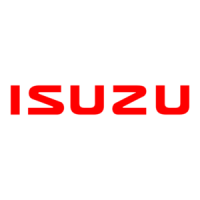
Do you have a question about the Isuzu L Series and is the answer not in the manual?
| Displacement | 5.2L |
|---|---|
| Horsepower | 215 HP |
| Cylinders | 4 |
| Compression Ratio | 17.5:1 |
| Fuel System | Direct Injection |
| Emission Standards | EPA 2010 |
Details engine applications and usage scenarios.
Outlines preventative maintenance tasks and intervals.
Describes design characteristics and family features.
Explains the function and parts of the fuel injection pump.
Details how to adjust fuel injection pump timing using shims.
Describes how the rack controls fuel injection quantity.
Illustrates the fuel flow and pressure stages during injection.
Covers the rocker arms, shaft, and their assembly.
Describes the camshaft lobes and bearing support.
Explains the critical timing marks for gears.
Details the forged steel crankshaft and its balancing.
Describes the cast iron block, bearing caps, and coolant flow.
Explains piston matching and clearance for assembly.
Describes the forged steel I-beam connecting rod.
Details the multi-layer head gasket and installation sequence.
Covers cast iron cylinder head, valve seats, and warpage specs.
Explains the wet sump oiling system and trochoid oil pump.
Details the lubrication system oil flow diagram.
Details the coolant flow diagram and maintenance.
Precise method for measuring initial fuel injection timing.
Procedures for adjusting valve clearances on cold engine.
Steps for cleaning and servicing fuel injectors.
Details on injector assembly and torque.
How to test nozzle opening pressure and spray pattern.
Procedure to check for fuel leaks from the nozzle.
How to test the resistance value of glow plugs.
Steps for installing new and reusing old hot plugs.
Key maintenance parameters like oil capacity and pressure.
Detailed mechanical tolerances for engine components.
Torque values for various engine fasteners and assemblies.
Specifies thread lockers, lubricants, and sealants for assembly.
Key maintenance parameters for 4L engines.
Detailed mechanical tolerances for 4L engine components.
Torque values for 4L engine fasteners.
Lubricant and sealant specs for 4L engines.
Analysis of common failures in the fuel system.
Further analysis of fuel system component failures.
Discusses failure causes related to the cylinder block.
Details common piston failure modes.
Identifies specific piston failure causes and wear.
Guide to diagnose nozzle issues based on symptoms.
Visual examples of nozzle spray patterns and their causes.
Specifications for tightening nozzle holder components.
Checks to determine the cause of low turbo boost pressure.
Procedure and interpretation of exhaust temperature tests.
Method for measuring crankcase pressure.
Procedure for testing boost pressure.
Limits for used oil analysis parameters.
Discusses engine re-engineering and EPA regulations.
Describes the physical design and construction of L-Series engines.
Focuses on noise and vibration reduction efforts.
Explains analysis techniques and DI combustion strategy.
Highlights efficiency improvements and compliance.
Summarizes the key benefits of the new DI L-Series engines.
